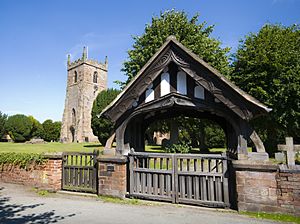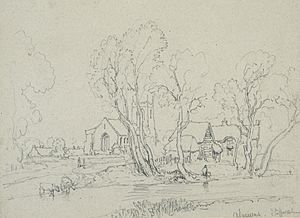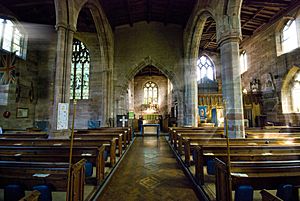All Saints Church, Alrewas facts for kids
Quick facts for kids All Saints' Church, Alrewas |
|
|---|---|

All Saints' Church, Alrewas
|
|
| 52°44′05″N 1°45′11″W / 52.734764°N 1.753095°W | |
| Location | Alrewas, Staffordshire |
| Country | England |
| Denomination | Anglican |
| Website | www.alrewasallsaints.church |
| Architecture | |
| Functional status | Active |
| Heritage designation | Grade I listed |
| Designated | 20.11.1986 |
| Architectural type | Church |
| Style | Gothic |
| Administration | |
| Parish | Alrewas |
| Deanery | Lichfield |
| Archdeaconry | Lichfield |
| Diocese | Lichfield |
| Province | Canterbury |
All Saints' Church in Alrewas is a beautiful old church located in the village of Alrewas, Staffordshire, England. You can find it in the northwest part of the village, right next to the Trent & Mersey Canal. This church is very special because it's a Grade I Listed Building, which means it's a really important historical site. People have worshipped on this spot for a very long time, since at least the 10th century! The church you see today was mostly built over many years, during the 1200s, 1300s, 1500s, and 1800s.
Contents
History of All Saints' Church
A church has stood on this site since at least the year 822 AD. The very first building was probably made of wood with a roof of reeds. Alrewas was a busy village back then. It was owned by important people like Ælfgar, Earl of Mercia and later by King John.
Norman Church Building
The Normans, who came to England in 1066, replaced the simple wooden church with one made of local stone. This stone church likely stood where the main part of the church (the nave) is today. You can still see parts of this original Norman building. Look for the tower doorway, the door in the north aisle, and some large, rough stone pieces in the north wall. These are the oldest parts of the church.
Changes in the 13th and 14th Centuries
During the 1200s, a beautiful new part called the chancel was added. This part of the church has tall, narrow windows called lancet windows. It also has special features like a piscina (a basin for washing sacred vessels), a sedilia (seats for priests), and a priest's door. A small bell was hung by a window in the north wall. It was rung during a special part of the church service.
In the 1300s, the main part of the church (the nave) and the south aisle were built. The old Norman doorway in the north wall was kept. Other features from this time include a "horseshoe" arch that separates the nave from the chancel. The tall, impressive tower was also built then, and the old Norman west door was moved to its base.
Additions in the 16th Century
In the 1500s, more changes were made. Windows were added high up on the walls, called clerestory windows. These run along the length of both the nave and the chancel, letting in more light. The beautiful carved wooden roofs of the nave and south aisle were also built during this period.
19th Century Restorations
- 1866: The porch, which is the entrance area, was rebuilt. Above it, you can see an old sundial. On the stone support (buttress) to the right of the porch, there is an ancient mass dial, which was used to tell the time for church services.
- 1877: The chancel was repaired and updated. The large east window was changed and filled with new stained glass. The walls and roof of the chancel were fixed. The floor was laid with marble and tiles. A new carved stone screen was also put in place. The church reopened for services on November 21, 1877.
- 1891: The north aisle was built, making the church look more balanced. This work cost about £1,600 at the time. It started in March 1891 and finished in November. The north wall of the nave was moved further north, and new arches and columns were built to support the roof. An old Norman doorway was included in the new north wall. A carved oak screen was also added in memory of a former vicar's father. The floor was laid with wooden blocks.
- The stained glass windows in the north aisle were made by a famous artist named Charles Eamer Kempe. The screen in the chancel was put up in 1892.
Special Features of the Church
All Saints' Church has many interesting things to see:
- Wall Paintings: In medieval times, the church walls were covered in colorful paintings. During the Protestant Reformation, these paintings were covered with whitewash. When the church was restored in the 1800s, some parts of these old paintings were found. You can still see a small piece on the north wall of the chancel.
- Ancient Chests: The church has two very old chests. These were once used to store important documents, like the records of the local manor court. They probably date back to the 1300s.
- Octagonal Font: The font, which is used for baptisms, is shaped like an octagon (eight sides). It has four lions carved at its base and dates from the 1400s.
- Carved Pulpit: The wooden pulpit, where the priest gives sermons, was made in 1639. This was during the time of the English Civil War. It is considered one of the best examples of 17th-century woodwork in the area.
- Oak Altar Table: The altar table, made of oak, dates from 1638.
- Church Bells: The church has 8 bells. They were recast (melted down and made new) in 1922. Before that, there were bells from 1585, 1618, and 1711.
- Monuments: At the east end of the south aisle, there are some beautiful monuments. Two are from the 1700s, and one is even older. This part of the church used to be the private chapel of the Turton family, who were important landowners in Alrewas.
- Church Organ: A new organ was installed in 1882 by a company called Brindley & Foster. It originally had 16 "speaking stops" (different sounds), and now has 19. You can find more details about this organ on the National Pipe Organ Register.
- Turret Clock: A new clock was put in the tower in 1887. It cost about £124 at the time. It has two clock faces on the tower and plays the famous Cambridge Chimes. It was built by Mr. Smith of Derby.
Vicars of Alrewas
Many vicars have served All Saints' Church over the centuries. Here are some of them:
- 1547 Robert Alsop
- 1569 John Faulkner
- 1619 William Bockinge
- 1637 Richard Martin
- 1646 John Bould
- 1657 Thomas Bladen
- 1669 Isaac Sympson
- 1676 Jonathan Jenner
- 1696 John Bradley
- 1708 Matthias Langley
- 1728 Joshua Piper
- 1739 John Fletcher
- 17?? Daniel Remington
- 1789 Charles Baldwin
- 1797 John Edmunds
- 1801 John Wainwright
- 1814 William Oster
- 1818 Hugo Bailye
- 1830 John Hinckley
- 1832 John Moore
- 1851 R.K. Haslehurst
- 1868 George Fraser
- 1869 William Horatio Walsh
- 1875 William Inge
- 1881 William James Webb
- 1890 William A. Webb
- 1923 Edgar Burford
- 1929 Thomas H. Brookes
- 1931 Jasper Stoneman Caiger
- 1937 W. Dennis Boone
- 1941 Hugh F. Hodge
- 1947 John Griffiths
- 1964 David H.N. Wells
- 1974 John E. Colston
- 1988 Stanley J. Morris
- 2001 John W. Allan
All Saints' Church Today
All Saints' Church is still a very active part of the Alrewas village community. It holds Sunday services, including an 8 AM Holy Communion and a 10 AM Family Service. There is also a group of people who ring the church bells.
The church's name is also used for the All Saints Bowling Club. This club is located between the church and the Trent & Mersey Canal. There is also an All Saints Church of England Primary School, which is the main primary school in Alrewas.
See also
- Grade I listed churches in Staffordshire
- Listed buildings in Alrewas




